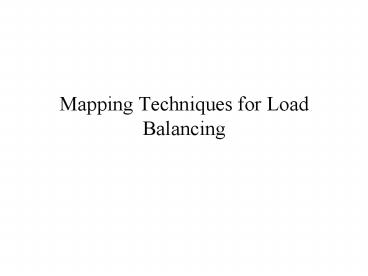Mapping Techniques for Load Balancing - PowerPoint PPT Presentation
Title:
Mapping Techniques for Load Balancing
Description:
Message-Passing Platform (MPP) Logic machine view of MPP consists. p processing nodes ... Two key attributes of MPP. It assumes a partitioned address space ... – PowerPoint PPT presentation
Number of Views:17
Avg rating:3.0/5.0
Title: Mapping Techniques for Load Balancing
1
Mapping Techniques for Load Balancing
2
Overheads
- Two sources
- Time spent in inter-process interaction
- Time of being idle
- A good mapping must ensure that computations and
interactions among processes at each stage of the
execution of the parallel algorithms are well
balance
3
Mapping Techniques
- Static Mapping distribute the tasks among
processes prior to the execution of the algorithm
- Dynamic mapping distribute the work among
processes during the execution of the algorithm - Dynamic mapping apply to
- if tasks are generated dynamically
- if task size unknown entail
- but if the amount of data associated with tasks
is large
4
Parallel Algorithm Models
- Data-Parallel Model
- Work Pool Model
- Master-Slave Model
- Pipeline or Producer-Consumer Model
- Hybrid Model
5
Communication Model of Parallel Platforms
- Two primary form of data exchange between
parallel tasks - Accessing a shared data space
- Exchanging message
- Shared-Address-Space Platforms view of a parallel
platform supports - a common data space that is accessible to all
processors - processors interact by modifying data objects
stored in it
6
Message-Passing Platform (MPP)
- Logic machine view of MPP consists
- p processing nodes
- either a single processor
- or shared-address-space multi-processors
- each with its own exclusive address space
- e.g. cluster workstations
- Messages
- data and work
- synchronize
7
MP Paradigm
- MP Paradigms support execution of a different
program on each nodes - Four basic operations
- Interactions send and receive
- ID for each processes. Using function whoami
- numprocs which specify the number of processes
- MP APIs
- MPI (Message Passing Interface)
- PVM (Parallel Virtual Machine)
8
Explicit Parallel Programming
- Numerous programming and libraries have been
developed - Difference in their view of
- address space
- degree of synchronization
- multiplicity of programs
- MPI is wide-spread adoption due to the fact that
it impose minimal requirements on hardware
9
Principles of Message-Passing Programming
- Two key attributes of MPP
- It assumes a partitioned address space
- each data element must belong to one of the
partitions of the space, i.e. data must
explicitly partitioned and placed - all interactions requires cooperation of two
processes - for dynamic and/or unstructured interactions the
complexity of code written is very high - It suppose only explicit parallelization
- decompose computations and extract concurrency
10
Structure of MP Programs(1)
- Asynchronous
- all concurrent tasks execute asynchronously
- harder to reason about can have
non-deterministic behavior due to race conditions
- Loosely synchronous
- tasks or subtasks synchronize to perform
interactions - between these interactions, tasks execute
asynchronously - easy to reason about
11
Structure of MP Programs (2)
- MP Paradigm supports execution of a different
program on each of the p processes - but makes the job of writing parallel program s
effectively unscalable - Most use single program multiple data(SPMD)
- code executed by different processes is identical
except - for a small processes (e.g. the root process)
- SPMD can be loosely synchronous or asynchronous
12
Building Blocks
- Send and Receive Operations (1)
- send (void sendbuf, int nelems, int dest)
- receive(void recvbuf,int nelems,int source)
- sendbuf points to a buffer that store data to be
sent - recvbuf points to a buffer that store data to be
received - nelems is the number of data units
- dest is the identifier that the process receives
data - source is the identifier of the process that
sends data
13
Send and Receive Operations (2)
- P0 P1
- a100 receive (a,1,0)
- send(a,1,1) printf(d\n,a)
- a0
- gtgtgtgtgt
- What p1 prints out?































